ChatGPT: Transforming the Way We Interact with Technology

February 8, 2023
A new form of artificial intelligence is on the rise, and it is taking over universities and professional occupations alike. ChatGPT (which stands for Chat Generative Pre-trained Transformer) has been in the talks of nearly everyone in the developed world, as the AI language model has passed several difficult exams, and proves to be both helpful and intimidating to anyone who creates an OpenAI account.
Here at the University of Minnesota, my marketing class has actually implemented and authorized the use of ChatGPT. In last week’s assignment, I used it to do an analysis of the renowned, but sadly discontinued, Choco Taco. The program gave me an impressive and comprehensive breakdown of the product, and what it meant to the Unilever brand. This is only the surface of its capabilities. It can even write code! I don’t see how universities can stop the use of ChatGPT, other than banning the site from its internet. However, this may not be such a great idea, as it is such a powerful tool that could revolutionize the ways that we write and communicate.

In this article, I used this impressive model to do my work for me. I even asked it to provide me with several title options, and was given five different options. I thought that the chosen option fit the best. The rest of this article (minus the concluding paragraph) was fully written by ChatGPT. I provided the model with this prompt: Write a 600 word essay about chat gpt:
ChatGPT is an AI language model developed by OpenAI, one of the leading artificial intelligence research organizations in the world. This model is trained on a massive amount of text data collected from the internet to generate human-like responses to natural language questions. The model uses a transformer-based architecture, a type of neural network that has been particularly effective in solving natural language processing tasks.
ChatGPT is a powerful tool that has a wide range of applications, from customer service and virtual assistants to language translation and content creation. Its ability to generate human-like responses makes it well suited for use in customer service, where it can answer questions and provide information about a company’s products or services. Additionally, ChatGPT can be integrated into virtual assistants to help users with tasks such as scheduling appointments, sending emails, and finding information.
One of the most notable features of ChatGPT is its ability to generate text that is both coherent and relevant to the input. The model has been trained on a massive amount of data, including books, articles, and websites, which allows it to generate a wide variety of responses to different questions. This means that ChatGPT can provide information about a wide range of topics, from science and technology to history and culture.
Another important aspect of ChatGPT is its ability to generate responses in a conversational style. This allows the model to engage in back-and-forth conversation with users, making it a valuable tool for customer service and virtual assistants. Additionally, the model can also be used to generate chatbots that can respond to user inputs in a natural and engaging manner.
Despite its many strengths, ChatGPT is not without limitations. One of the biggest challenges with AI language models is that they are only as good as the data they are trained on. This means that if the model is trained on biased or inaccurate data, it will generate biased or inaccurate responses. For example, if the model has been trained on data that is predominantly written by men, it may generate responses that are gender-biased.
Additionally, ChatGPT is not perfect when it comes to understanding context. The model may generate responses that are not entirely relevant to the input, or it may generate responses that are not appropriate for the situation. This is a common problem with AI language models, and it highlights the importance of ongoing research and development to improve their performance.
Another issue with ChatGPT is that it requires a lot of computational resources to run. The model is so large that it requires specialized hardware and software to run effectively. This can make it difficult for small businesses or individuals to use the model, as they may not have the resources or expertise required to set it up and run it effectively.
In conclusion, ChatGPT is a powerful and versatile AI language model developed by OpenAI. Its ability to generate human-like responses to natural language questions makes it well suited for use in customer service, virtual assistants, and chatbots. However, the model is not without limitations, and ongoing research and development is needed to improve its performance and make it more accessible to a wider range of users. Despite its challenges, ChatGPT has the potential to revolutionize the way we interact with technology and has the potential to be a game-changer in the world of artificial intelligence.
Now it’s me again, gawking at the abilities of this technology. I literally cannot imagine how far we will be in 50 years. Perhaps there will be the singularity, and artificial intelligence will take over the world. I am not so pessimistic. I think there is a lot that humans can do that a program cannot do. Maybe we’ll get there at some point, but not so fast. There is a duality of things in life, like light and dark, matter and energy, men and women, etc. One cannot exist without the other. Maybe AI is the dual opposite of mankind. We both need each other in order to coexist. Maybe it’s wishful thinking but I remain optimistic about the future, even if it includes living alongside something as powerful as sentient technology.











